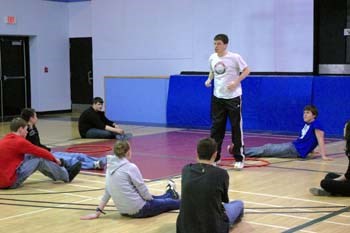The use of technology in high school is not limited to students texting and listening to iPods.
In Todd Harwood's physical education classes, it's letting him know which students are loafing.
It's Wednesday morning at R.D. Parker Collegiate and Harwood's students are drifting in from the change room, where they've wetted down their heart rate monitors and fitted them around their chests.
"There are three pieces to the heart rate monitor," Harwood explains. "There's an elastic strap and then a chest piece and so how it works is this piece picks up the electrical signal from your heart. The kids all right now have one on. That beams a signal up to the watch once the heart rate monitor is running."
The P.E. department received a matching grant of $2,576 from the Thompson Community Foundation to purchase four sets of 12 heart rate monitors to go along with another dozen that the department bought before.
"They matched what two sets of these heart rate monitors are worth," said Harwood.
There are several advantages to using the heart rate monitors in gym class, says Harwood, including the fact that they produce tangible and measurable results.
"There is no faking it, right?" said Harwood.
Students have come to realize that, something their teacher recognizes during lessons when he breaks out the heart monitors.
"They all hate wearing them," he says. "We don't use them every single day."
Once the heart rate monitor is running, a screen on the watch shows what the wearer's pulse is in beats per minute. The monitors at the school have been programmed with an average student's target heart rate zone, which is between 135 and 180 beats per minute, typically generated by moderate to vigorous exercise.
"It tallies up 10 minute increments so their assignment is at the end of this class to get 30 minutes in their target heart rate zone," Harwood explains. "They have to show me their watch with three little dots. That's their kind of completed assignment."
The activities they do to get their heart rate going are varied. In this particular class, they begin with 11 jogging laps around the gym, then move on to some weight-bearing strength exercises on the floor before dividing into two teams for a game of pinball, with each side trying to knock down bowling pins standing at the other end of the gym while blocking their opponents' shots.
"Every teenager should get 60 minutes of moderate to vigorous physical activity [per day]," says Harwood. In this class, which runs just over an hour, they should be getting at least half of that.
"The other thing that the watches do is you can hear some of them beeping," says Harwood. "The beeping tells you that you're not in your target zone. It's making kids accountable for their time and actually getting some benefit. There are no real health benefits to having light activity."
Using the monitors also makes things fairer for kids of differing abilities and fitness levels. Those who aren't in as good a shape as others don't have to compare themselves to the top athletes, or have their teachers do that.
"It takes away that guesswork, 'Oh, he's working pretty hard,'" says Harwood. "The other thing it does, it also evens the plateau."
Harwood points out one of the students in the class, Drake Bodie, who played hockey with the Norman Northstars and on Manitoba's provincial team at the Canada Winter Games.
"He's got to work harder to get into his heart rate zone," said Harwood, while those at a lower fitness level can reach the target zone - and begin to reap the fitness benefits - by walking at a decent pace, despite the fact it would appear their level of exertion is lower. "This is what evens the playing field."




